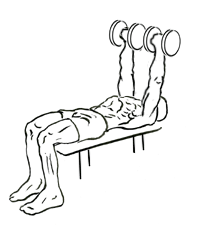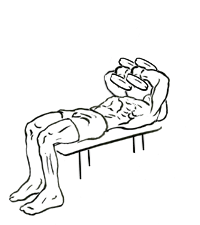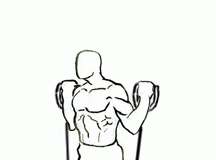Last Updated on September 24, 2014
The Tate Press is a unique and challenging triceps exercise that takes a different approach to engaging the tricep muscles. Unlike other tricep exercises, the Tate Press is designed to isolate and strengthen the triceps through a range of motion that’s rarely utilized, which can lead to improved definition, strength, and overall arm growth.
This comprehensive guide covers the essentials of the Tate Press, from its benefits and step-by-step instructions to advanced tips, common mistakes to avoid, and variations to keep your workouts dynamic.
Benefits of the Tate Press with Dumbbells
- Targets the Long Head of the Triceps: Unlike conventional tricep exercises, the Tate Press primarily activates the long head of the triceps, which contributes significantly to arm size and helps develop a well-rounded tricep shape.
- Reduces Shoulder Involvement: The movement pattern minimizes shoulder engagement, isolating the triceps more effectively than exercises like the overhead press or close-grip bench press.
- Enhances Elbow Stability: Performing the Tate Press strengthens the stabilizing muscles around the elbow, which can improve performance in other pressing movements.
- Great for Advanced Lifters: As an advanced triceps exercise, the Tate Press is perfect for experienced lifters looking to break through plateaus and achieve balanced arm development.
- Improves Lockout Strength: This exercise’s unique angle emphasizes the tricep lockout, which is valuable for lifters who struggle with the top portion of pressing exercises.
How to Perform the Tate Press with Dumbbells: Step-by-Step Guide
Step 1: Setting Up on the Bench
- Positioning: Lie flat on a bench with your head near the end and your feet planted firmly on the floor. Your feet should provide stability, so keep them grounded throughout the exercise.
- Core Engagement: Draw your abs in and keep your lower back pressed against the bench to maintain a stable and safe position.
Step 2: Holding the Dumbbells
- Grip the Dumbbells: Hold a dumbbell in each hand with your palms facing your feet (a pronated grip). Unlike the neutral grip used in many tricep exercises, this grip is essential for the Tate Press.
- Arm Positioning: Position your arms so that the weights are aligned with the center of your chest, keeping your elbows flared out. This setup creates the ideal starting point to target the triceps effectively.
Step 3: Execute the Movement
- Press Upward and Outward: Without moving your elbows, lift the dumbbells upward and slightly outward. As you press, contract your triceps, feeling the tension along the long head of the muscle.
- Avoid Full Extension: The movement should be short and controlled, focusing on the triceps rather than achieving a full extension of the arms.
Step 4: Lowering Back Down
- Controlled Descent: Slowly lower the dumbbells back down to the center of your chest, keeping your elbows in the same flared-out position. This controlled descent helps maintain tension on the triceps and improves muscle engagement.
- Repeat the Motion: Aim for 3-4 sets of 8-12 reps, prioritizing controlled form over the amount of weight lifted.
Tips to Maximize Tricep Activation in the Tate Press
- Focus on a Short Range of Motion: Unlike a typical press, the Tate Press uses a shorter range to keep the focus on the triceps. Lift the weights only as high as you can while keeping the tension on the muscles.
- Keep Elbows Flared: Maintaining flared elbows is key to isolating the triceps. Avoid letting your elbows drift inward, as this reduces the effectiveness of the exercise.
- Control the Weight: Due to the Tate Press’s unique movement, using lighter weights allows you to perfect the form and fully activate the triceps.
- Avoid Momentum: Keep the movement slow and controlled. Using momentum can reduce muscle activation and increase the risk of injury.
Common Mistakes to Avoid
- Locking Out the Elbows: Fully extending the arms takes tension off the triceps. Aim for a partial extension at the top of the movement to keep the focus on the muscles.
- Using Excessive Weight: Heavy weights can compromise form and make it difficult to maintain the necessary elbow position. Start with lighter weights and progress gradually.
- Moving the Elbows: Keep the elbows stationary. Moving them during the exercise shifts the focus away from the triceps and onto other muscles.
- Rushing Through the Reps: Fast reps reduce muscle engagement and increase the chance of using momentum. Slow, deliberate movements maximize the benefits of the Tate Press.
- Neglecting Core Stability: Keeping your core engaged helps maintain stability and prevents unnecessary arching of the back.
Variations of the Tate Press
Once you’re comfortable with the standard Tate Press, try these variations to add variety and challenge to your triceps training.
1. Single-Arm Tate Press
- How to Do It: Perform the exercise with one arm at a time, holding only one dumbbell. Keep the other arm extended or resting on your torso.
- Benefits: This variation allows you to focus on each arm individually, helping to address any muscle imbalances.
2. Incline Tate Press
- How to Do It: Set the bench to a slight incline (15-30 degrees) and perform the exercise as usual.
- Benefits: The incline position places additional emphasis on the long head of the triceps, further enhancing the stretch and contraction.
3. Floor Tate Press
- How to Do It: Lie flat on the floor instead of a bench, keeping the dumbbells above your chest.
- Benefits: This modification limits the range of motion and provides added stability, making it a good option for beginners or those with lower back issues.
Muscle Anatomy and Mechanics: Why the Tate Press Works
The triceps brachii consists of three heads: the long head, lateral head, and medial head. The Tate Press primarily targets the long head of the triceps, which is often underutilized in traditional pressing exercises. This focus on the long head promotes balanced tricep growth and enhances the appearance of the upper arm.
Additionally, the Tate Press places minimal stress on the shoulder joints, which is beneficial for lifters who experience shoulder discomfort with traditional pressing exercises. This targeted movement pattern also helps improve elbow stability, as the triceps are the primary muscles responsible for elbow extension.
Frequently Asked Questions
1. Is the Tate Press suitable for beginners?
- While the Tate Press is technically an advanced exercise, beginners can try it with very light dumbbells or perform it on the floor for added stability.
2. Can I do the Tate Press with other equipment?
- Although the Tate Press is traditionally done with dumbbells, you can also try it with a barbell (using a narrow grip) or cables to change the angle of tension.
3. How often should I include the Tate Press in my routine?
- For most, 1-2 times per week is sufficient. Adding it as part of an arm day or upper-body routine can help improve tricep growth and strength.
4. Is the Tate Press safe for people with elbow issues?
- If you have elbow issues, use light weights and keep the movement slow and controlled. Consulting with a fitness professional can help determine if this exercise is suitable for you.
Integrating the Tate Press into Your Routine
The Tate Press is a versatile exercise that can complement any tricep or upper body workout. Here are some ways to incorporate it effectively:
- Tricep Focused Workout: Include the Tate Press at the beginning of your tricep routine to emphasize the long head of the triceps before moving on to other pressing or extension exercises.
- Arm Superset: Combine the Tate Press with a bicep exercise, like dumbbell curls, for a balanced arm workout.
- In a Push Workout: Pair the Tate Press with chest exercises like the bench press or chest flyes as part of a comprehensive push workout for upper body strength.
- As a Finisher: Use lighter weights and higher reps for the Tate Press at the end of your arm workout to fully exhaust the triceps and promote muscle growth.
Progressing with the Tate Press: Advanced Techniques
- Slow Tempo Reps: Lower the weights even more slowly to increase time under tension. Aim for a 3-5 second descent with each rep.
- Rest-Pause Sets: After reaching muscle fatigue, rest for 10-15 seconds and then perform a few more reps. This technique helps push your triceps to their limits and promotes hypertrophy.
- Drop Sets: Start with a challenging weight and, upon reaching failure, reduce the weight and continue the set. Drop sets maximize muscle engagement and are ideal for experienced lifters.
- Adding Bands: For added resistance, you can loop a resistance band around your arms to increase tension on the way up and challenge the triceps even further.
Wrapping Up: Building Powerful Triceps with the Tate Press
The Tate Press with dumbbells is an advanced yet highly effective triceps exercise that offers unique muscle activation. By mastering this exercise, you can enhance the shape, size, and strength of your triceps, leading to well-rounded arm development and improved performance in pressing movements.
Whether you’re looking to add variety to your tricep routine or break through a training plateau, the Tate Press offers an excellent solution. Its unique range of motion, combined with its emphasis on the long head of the triceps, makes it a valuable addition for those serious about building strong, defined arms.
By following the steps, tips, and advanced techniques outlined in this guide, you can safely and effectively incorporate the Tate Press into your workouts. Remember to start with light weights to perfect your form, gradually progressing as you gain strength and control. Consistency and proper execution are key to maximizing the benefits of this exercise.
As you continue to master the Tate Press, you’ll notice improved tricep strength, enhanced arm definition, and greater stability in your pressing movements. This will benefit not only your aesthetics but also your performance in various upper-body exercises, contributing to a more balanced and powerful physique overall.








